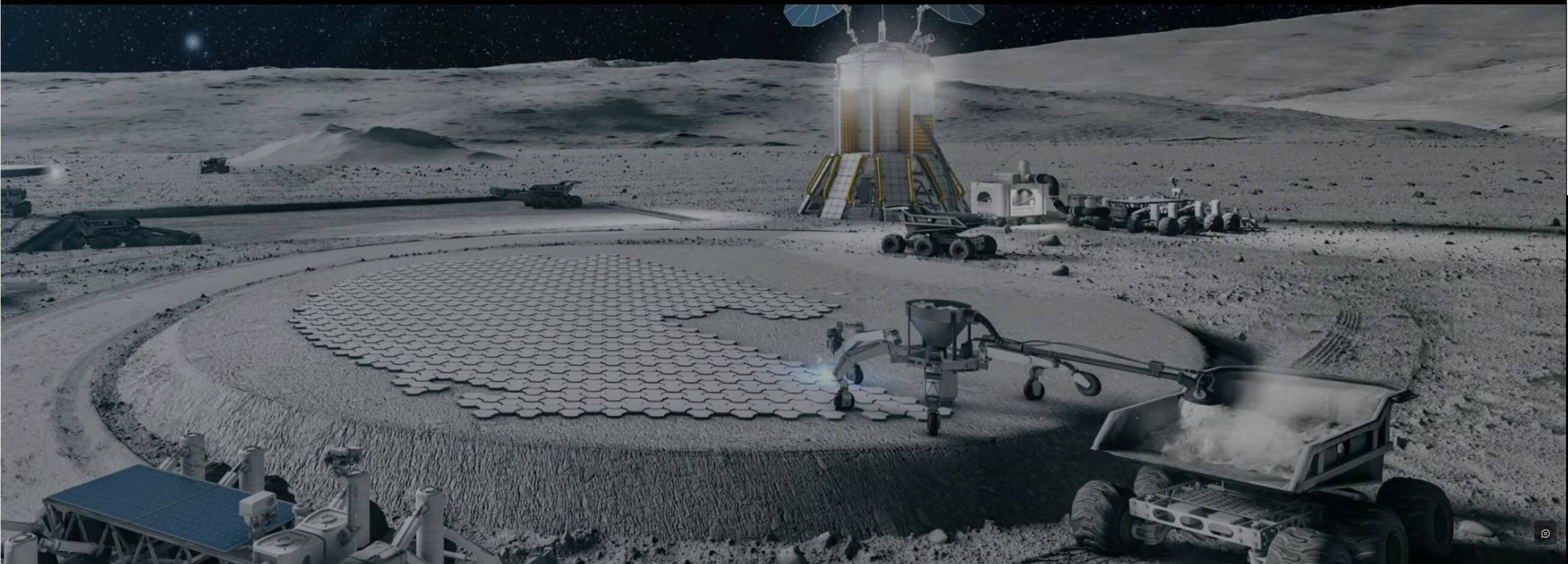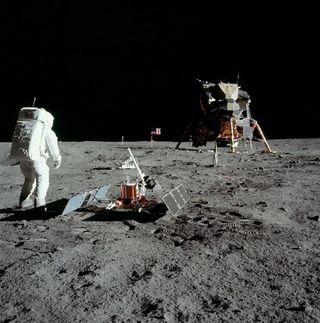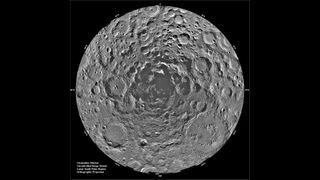23.09.2024
The installation of habitats, landing pads, equipment shelters, tall towers on the moon could be off to a shaky start.

Earth's moon is viewed as a major construction site as roads, shelters, launch and landing pads are emplaced to sustain a permanent foothold on this celestial destination. (Image credit: Astroport Space Technologies)
New research indicates that potential landing sites at the moon's south pole for robotic landers and crewed Artemis missions are susceptible to quakes and landslides.
Science results published early this year in the Planetary Science Journal point to a group of faults located in the moon's south polar region, making use of data on moonquakes recorded by seismometers set up by Apollo moonwalkers over 50 years ago.
"The potential of strong seismic events from active thrust faults should be considered when preparing and locating permanent outposts and pose a possible hazard to future robotic and human exploration of the south polar region," the research paper explains.
Lunar building codes
The installation of habitats, landing pads, equipment shelters, tall towers on the moon could be off to a shaky start, suggests Nerma Caluk, an intermediate designer and lunar specialist for Skidmore, Owings & Merrill, an architecture and structural engineering firm in San Francisco, California.
As public and private entities are seeking to establish building infrastructure on the lunar surface, a need for lunar design criteria will be more apparent with time, said Caluk. Unlike terrestrial building codes, the lunar building codes are non-existent, she observed.
To wrestle with this issue, a Space Engineering and Construction committee, part of the American Society of Civil Engineering (ASCE) Aerospace Division, is developing a guideline document.
"One of the crucial sections of this guideline document is the seismic design criteria," Caluk said, "in which information such as site-specific requirements, minimum design force, fatigue and service considerations will be addressed."
That criteria work is currently being undertaken as part of a NASA Small Business Technology Transfer program grant, during which Skidmore, Owings, & Merrill, Slate Geotechnical Consultants, and Colorado School of Mines are addressing the concerns of the lunar seismic hazard on a variety of structural systems.
Caluk said that terrestrial engineering practices and codes "will need to be re-imagined" to address the factors that are not present on Earth. And one of those factors is moonquakes.
Old data, new challenges
The uniqueness of lunar seismic activity imposes new challenges, said Caluk. "Additionally, applying statistical models developed for earthquake recordings could lead to uncertainties in the lunar environment due to the limited information on geological and tectonic processes that drive the lunar seismic activity."
Caluk recalls that, during the Apollo missions, five seismic stations were deployed on the lunar surface. Each of the seismic instruments was equipped with three long-period seismometers, originally aligned to measure all three components of the ground displacement vectors, and one short-period seismometer, with capability of only measuring vertical ground motion.
Even though over 13,000 seismic events were charted during the 7-year recording period, the limitations of the on-site Apollo instruments were recognized, said Caluk.

Fatigue-induced cracks
However, based on the seismic events mapped on the moon, "the main difference between the terrestrial and lunar seismicity is their duration. It takes between half an hour to several hours for the lunar seismic energy to completely dissipate during an event," Caluk advised.
Among four identified types of lunar seismic events, shallow moonquakes were found to present the highest amplitude and energy release per event.
Albeit they are estimated to have smaller magnitudes than high-impact earthquakes, if large enough — with the epicenter being close to a south pole site — they could damage lunar infrastructure, said Caluk, "potentially causing fatigue-induced cracks, affecting their serviceability and operation."
Moonquake effects on future lunar structures in the low-gravity environment, that will possess unique structural material properties, could significantly differ from known, terrestrial cases, Caluk emphasized. Adaptive resilient-based seismic systems that mitigate seismic damage have made significant advancements in recent years and must be refined for lunar structures, she said.

Narrowing the knowledge gap
Existing data can be used for initial estimations, Caluk said, narrowing the knowledge gap in the seismic analysis for lunar structures. That's possible by using a shallow moonquake waveform database to develop a Lunar Ground Motion Model (LGMM).
"In order to properly design for such lateral loads, data on the seismic activity from the actual base camp site, in this case being the lunar south pole, is required," said
Caluk. "This data currently does not exist since the seismometers of the Apollo missions are placed at the equatorial regions."
The ongoing NASA-funded work is intended to provide for initial estimations and assumptions that are a result of limited knowledge on moonquakes, their effect on structural systems and potential need for seismic protection systems.
Wanted: More data
But there's more work to be done, Caluk said. More data can be gleaned from future lunar seismometers.
One extra outcome of the on-going work on moonquakes is perhaps instigating a need for additional instrumentation onboard NASA Commercial Lunar Payload Services (CLPS) public-private missions to collect the missing data for local site conditions.
"As NASA returns to the lunar surface through the Artemis program, establishment of structurally safe and permanent building infrastructure is needed," Caluk concluded. "Terrestrial structural and civil engineering experience must be incorporated to accelerate the development of lunar infrastructure and building systems."
Stable foundation
As for moonquakes, "designers need to factor them into any design of structures requiring a stable foundation," said Sam Ximenes, a space architect, founder and CEO of XArc Exploration Architecture Corporation and Astroport Space Technologies headquartered in San Antonio, Texas.
"Yes, this is getting very real," Ximenes said, with work underway developing patent-pending regolith solidification technologies for lunar infrastructure construction using 3D printing and autonomous robotics, with an initial focus on lunar landing pad emplacements.
"The natural progression is toward the cislunar economy, where we are now starting to see industry alliances forming for enabling a supply chain infrastructure encompassing lunar surface in-situ resource utilization," Ximenes told Space.com.
Towering capability
Honeybee Robotics is working with the Defense Advanced Research Projects Agency (DARPA) on a lunar architecture study to develop and integrate its tall tower concept.
The concept is dubbed the LUNARSABER, space shorthand for the lengthy title: Lunar Utility Navigation with Advanced Remote Sensing and Autonomous Beaming for Energy Redistribution.
This towering capability is projected by Honeybee Robotics to be nearly 330 feet (100 meters) tall, but could be scaled to over 650 feet (200 meters) in height above the lunar landscape to boost its service range.

Site selection
Vishnu Sanigepalli is Honeybee's principal investigator of LUNARSABER on the DARPA LunA-10 effort.
"We are actively evaluating the impact of moonquakes on tall infrastructure, including deployable towers like Honeybee's LUNARSABER, and designing them to ensure they remain stable and won't tip over," Sanigepalli tells Space.com.
Unlike Earthquakes, which last only a few seconds, moonquakes can persist for hours, Sanigepalli pointed out, raising risks about long-term effects, such as material fatigue, structural durability, and service degradation.
"For towers, habitats, and other infrastructure, moonquakes pose a challenge, especially because the moon's regolith is much less stable than Earth's," Sanigepalli added.
"This means we must be more rigorous in our site selection to ensure that infrastructures are built on terrain capable of withstanding seismic activity for long-term stability," Sanigepalli concluded.
Quelle: Space.com
